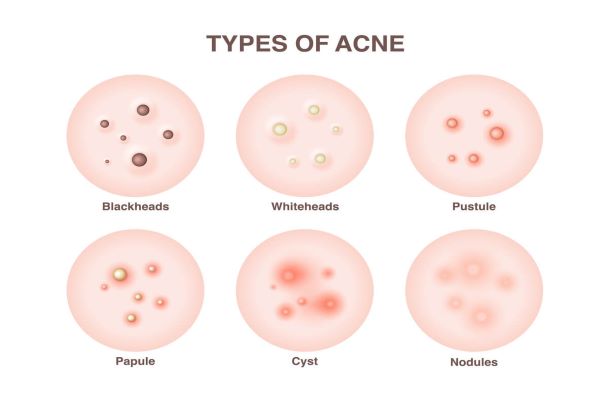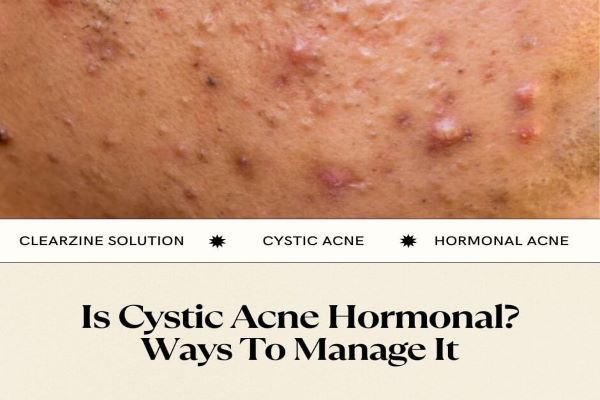So if you asked, is cystic acne hormonal, or is it treated differently to how you treat other forms of acne? There are THREE initial parts to this answer.
1) Cystic acne can be caused by hormonal imbalance in adult women.
2) It is also common among teenagers and adult males.
3) Anyone can end up with cystic acne.
However, if you were having premenstrual syndrome (PMS) for reasons that may include PCOS, perimenopause, or cessation of oral contraceptive pill (OCP). you will likely experience imbalance in your hormonal state.
How can you then manage cystic acne?
| Cystic and Hormonal Acne Product | Active Ingredients | Indication | Certification and Highlights | Price | What Next? |
| ClearZine Solution (for men and women) | Vitamin B5, D-biotin. Natural minerals (Selenium, chromium, Zinc). Witch-hazel extract, horse tail extract. CoQ10 | Cystic Acne, Hormonal Acne, Mild to severe Acne | 100% vegan friendly, 100% vegetarian safe. Fee of gluten, diary, egg, yeast, lactose, preservatives and other harmful substances. Kosher certified. | $37.89 | SHOP NOW |
(As an Amazon Associate I earn from qualifying purchases. Full disclosure…)
Where Does Hormonal Cystic Acne Appear?
A facial mapping showing cystic acne appearing along your chin or jaw line may be an indication that it is related to hormonal imbalance. You may have seen this being referred to as “hormonal belt”
On the other hand, cystic acne that is not hormonal can appear appear on the face, neck, chest and back.
There are also people who also end up with acne cysts on their shoulders and behind the ears.
How Can You Identify Cystic Acne?
There are features that can help you identify that your acne is cystic.
Cystic acne appears as painful, large pus filled lump, and they occur under the skin surface. You may notice that it appears inflamed, red and painful to touch. The lesions can be white, pus-filled bumps that look like boils.
How Is Cyst Different From Pustules?

If your acne lesion is caused by an infection in your pores, you will notice pus like liquid in your lesion.
Acne cysts contain liquid or pus that are similar to that of pustules. However, cysts are generally larger than pustules. The diameter of cysts is usually 5mm or more.
Acne cysts extend below the skin surface and considered the most severe of all acne lesions. On the other hand, pustules are like papules but with pus at the top, and are less severe than cysts.
A group of pustules can come together under the skin and form a cyst that becomes hard and painful.
What Are Other Forms of Acne?
According to the American Academy of Dermatology Association, note that there are different forms of acne lesions that vary in severity.
Comedones
These are early days, non-inflammatory forms of acne.
They can appear as either whiteheads (closed) or blackheads (open). Comedones are the least severe forms of acne, and usually smaller than other forms.
Note that blackheads appear black because your pores stay open unlike whiteheads; blackheads are not dirt. So don’t be tempted to think they are dirt and start scrubbing excessively.
Papules
These are inflammatory forms that appear as small raised solid bumps on the skin, usually less than 5 mm but larger than comedones.
Pustules
They are similar to papules but their lesions contain pus and they appear white at the top.
Nodules
Nodules appear as large, painful and hard lesion that go deep into your skin. It can either have a similar tone as your skin or can become red as it gets inflamed.
Cystic Vs Nodules
Cysts are soft while nodules are hard.
Also, cyst are filled with pus unlike nodules.
However, they both extend deep under the skin, inflamed, painful to touch.
When cyst and nodules exist together – nodulocystic – they are considered the most severe forms of acne. They will typically need medical attention and are larger than papules and pustules.
You will notice that your surrounding skin may also appear irritated.
How Does Cystic Acne Develop?
Well, for a better answer, a basic understanding of how acne develops before becoming cystic may be helpful.
Generally, acne starts with excess oil (sebum) being trapped in your pores with dead skin cells. This is when you see the non-inflammatory forms of acne called open comedones (blackheads) and closed comedones (whiteheads).
When Propionibacterium acne (P. acne) which normally resides in your skin gets trapped along with excess oil and dead skin cells in your pores, the affected pores will become red and swollen, and inflamed.
The inflammatory forms of acne that will develop include papules, pustules nodules and cysts.
The most severe of all forms of acne is cystic acne.
Why You Should Never Squeeze or Pop Cysts
You must avoid squeezing or popping your cysts and nodules, or any other type of acne lesion for that matter.
If you squeeze or pop your acne lesions, or cysts, you risk the following;
- scarring
- dark spots
- prolonged time for your acne to clear.
- spreading of infection
- pushing of the content of your lesion deeper, thereby causing more severe form of acne lesion.
You can read about 7 tips for managing acne and prevent recurrence.
Will You Develop Scars?
Cystic acne being the most severe is more likely to develop scars than any other form of acne.
Depending on your treatment option, cystic acne can take up to 8 weeks to start seeing result.
However, if scar or spots develop, it can take several months of even years to clear. And in some cases, your scars may become permanent.
What you can do to prevent scarring is to seek early and appropriate treatment and never squeeze or pop your cystic lesions.
Treatment for Cystic Acne
Due to the severity of cystic acne, medical interventions are usually your best bet, as over the counter (OTC) products may not be potent enough to treat it.
Talk to your doctor about cystic acne treatments that may include isotretinoin (accutane), antibiotics, topical retinoids, spironolactone and oral contraceptive pills.
Your doctor or dermatologist may come up with a treatment plan that is suitable for you. In some cases, you may require combination therapy.
Also asks your doctor or dermatologist questions regarding side effects that are associated with such treatments and what your alternatives are.
Due to side effects associated with prescription medications for cystic acne, some people would rather seek alternatives.
What Else Can You Really Do?
ClearZine Solution
ClearZine Solution is a leading anti-acne supplement known for its powerful skin clarifying ability. It is a powerful and clinically proven formula that contains high quality ingredients designed for people with hormonal breakouts, cystic acne and oily skin. It fights acne at its source.
It has a 4.1 (out of 5) global star rating. This rating is on amazon, so it is NOT influenced by the manufacturing company.
This high rating supports its claim as being an effective solution for treating mild to severe acne.
Why Does ClearZine Clear Cystic Acne?
Acne can be triggered or made worse by problems that occur well below the surface of the skin.
These problems can include vitamin deficiencies, hormonal imbalances, poor dietary and lifestyle choices, stress and more.
ClearZine helps fight off these problems at a deeper level unlike other skincare products that scratch the surface of the problem.
Its cleansing and clarifying ability can help restore your body hormonal balance, thereby regulating the level of androgenic hormone that’s known to be a major culprit in all forms of acne.
ClearZine Solution contains a blend of high quality ingredients with powerful antioxidant and anti-sebum properties. It contains vitamin B5 and D-biotin. Minerals such as selenium, chromium and zinc. A powerful enzyme known as CoQ10. It also contains potent plant extracts such Witch-hazel and horse tail extracts.
What do these ingredients do?
As shown in a shown in a study vitamin B5 can help remarkably reduce lesion count after 12 weeks of dietary supplement
D-biotin has evidence that supports its effectiveness in improving acne, including blackhead and whitehead, and controlling flaking and irritation that may have been caused by topical retinoids.
Selenium, chromium and Zinc found in this supplement have high antioxidant property that helps to clear reduce acne severity.
CoQ10 enzyme, a powerful antioxidant and anti-inflammatory substance, is also found in this supplement. It is known to help improve acne, make skin firm, as well as plump and smoothen your skin. It can also help reduce the appearance of fine lines and wrinkles.
Witch hazel and horse tail extracts are included in the formula. Witch hazel has astringent, antibacterial and anti-inflammatory properties that can help inhibit acne causing bacteria, minimize the appearance of pores and unclog pores. Horse tail has anti-inflammatory properties that help reduce acne.
Certification and highlights of ClearZine
It is certified as 100% vegan friendly and vegetarian safe. It is also free of gluten, diary, egg, yeast, lactose, preservatives and other harmful substances. It is kosher certified.
How to take it
1 bottle has 90 capsules. It is recommended that you take 1 to 2 capsules with each meal (breakfast, lunch and dinner) and before bed time. This gives a total of 4 to 6 capsules that should be taken a day.
Once acne is gone, you can maintain a clear skin with a lower dose.
To achieve maximum result, it is recommended that you use ClearZine for a minimum of 3 months (6 to 7 bottles).
Read more about other hormone balancing supplements (e.g. DIM supplement, AcneTame). These supplements are designed for men, women and teens that can help to reduce the severity of acne, prevent recurrence and help balance female hormones caused by PCOS, Premenstration etc.
If you find this helpful or want to share your experience, please leave a line or two (or however long) in the comment section below.
Disclaimer
This serves as informational material and not intended to be a medical advice. For medical advice about your acne, please consult with your doctor or dermatologist.
References
American Academy Association of Dermatologists (2022). How To Treat Different Types of Acne. How to treat different types of acne (aad.org)
Cherney, K. & Taylor, S. (2019). What is Cystic Acne and How Is It Treated? Cystic Acne: Identification, Causes, and More (healthline.com)
Farrell, L. N., Strauss, J. S., & Stranieri, A. M. (1980). The treatment of severe cystic acne with 13-cis-retinoic acid: evaluation of sebum production and the clinical response in a multiple-dose trial. Journal of the American Academy of Dermatology, 3(6), 602-611.
Gardner, S. S. (2020). Slideshow: Acne Visual Dictionary. Pictures: Different Types of Acne & How to Treat Them (webmd.com)
Marynick, S. P., Chakmakjian, Z. H., McCaffree, D. L., & Herndon Jr, J. H. (1983). Androgen excess in cystic acne. New England journal of medicine, 308(17), 981-986.
